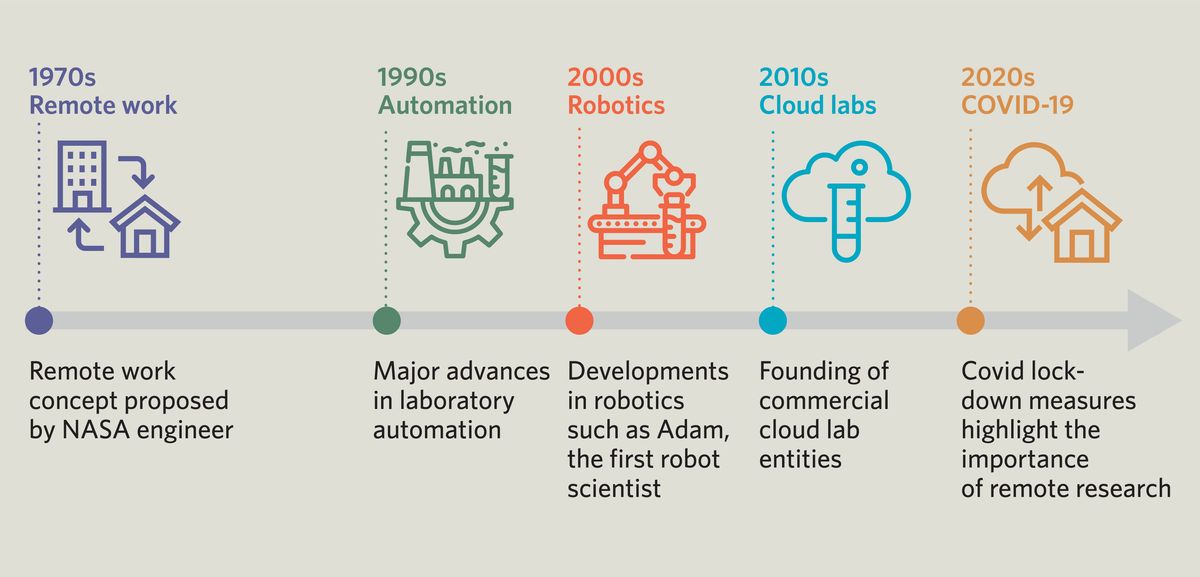Article reviewed by Dana Cortade, PhD from Align to Innovate.
Stay up to date on the latest science with Brush Up Summaries.

What Are Remote Labs?
Remote labs are physical laboratories that enable researchers to conduct experiments without being physically near the equipment. They offer remote access to raw reagents, instruments, sample preparation, and step-by-step experimental processes. Besides improving access to complex experiments for more researchers, remote labs can also minimize human error by automating workflows.1
What Are Cloud Labs?
Cloud labs are a type of remote lab that enables researchers to conduct their experiments remotely using a computer and cloud-based infrastructure.2 The cloud is an extensive network of software servers, which can be accessed through an online interface from any geographical location. Cloud labs provide access to software that coordinates automated scientific instruments, inventories (e.g., chemical reagents), and robots to perform experiments and process data.3 By logging into the cloud, researchers can carry out scalable, standardized, and robust biological protocols in remotely operated labs.
Inception and Development of Remote Labs for Scientific Research
The idea of remote work can be traced back to the 1970s when Jack Nilles, a NASA engineer, proposed the use of telecommuting to alleviate traffic congestion.4 The advent of personal computers and widespread internet access in the early 2000s has contributed to the concept of remote work being popularly accepted as a viable working arrangement across many disciplines.5
In scientific research, the outbreak of the covid pandemic highlighted researchers’ strong reliance on in-person work and the limitations of human-dependent experimental procedures.6 It was during this time that cloud labs gained immense popularity in the research community.7 Currently, the demand for cloud lab services is growing at a faster pace compared to pre-pandemic levels.

Technologies Used in Remote Labs
The creation of remote labs has been made possible by rapid progress in automation, facilitated by advances in robotics and artificial intelligence (AI).2,8
Lab automation
Automation is a multidisciplinary strategy that enables the operation of laboratory tools and instruments with minimum human interaction. Automation also improves sample throughput, which saves a considerable amount of discovery time and contributes to breakthroughs that are conventionally limited by manual methods. In order to automate their research, scientists depend on automated equipment. “We hope with time and innovation that more and more labs will have access to automation, whether it's within their own labs, in core facilities that they can use, or in commercial entities like cloud labs,” said Dana Cortade, a technical project manager at Align to Innovate, a scientific nonprofit organization that focuses on improving science via automation.
Robotics
Robotics play a key role in automating standard laboratory operations and reducing human errors. As an example, liquid handling robots in remote labs enable reagent preparation and sample transfer between different experimental steps with high precision.9 Automation using pipetting robots is another time-saving strategy for simultaneous processing of many samples while reducing contamination risks.10
Artificial Intelligence
AI has significantly contributed to the development of automated and remote labs. Within the realm of AI, machine learning (ML) uses mathematical models to perform complex prediction tasks. Cloud labs commonly use ML models to predict material properties and experimental outcomes, supporting automated and semi-automated workflows. AI-based algorithms help scientists analyze big data faster by automating the process.11
Examples of Remote Labs
Commercial cloud labs
Two examples of commercial cloud labs are Strateos and Emerald Cloud Lab.12,13 Both primarily provide services for industry researchers. Strateos develops in-house cloud lab platforms for private companies working on drug discovery and characterization. Emerald Cloud Lab provides many laboratory services, such as sample preparation, bioassays, DNA and peptide synthesis, bioimaging, and biomaterial characterization. Arctoris is another commercial remote lab that is a technology-enabled multinational contract research organization (CRO). It offers a remote-operated platform that is mainly focused on automated, AI-driven drug discovery and testing.14
Biofoundries
Biofoundries are another type of remote lab; they offer infrastructure for testing genetically engineered organisms for different biotechnological applications, such as the production of antibiotics, bioplastics, and biofuels.15 Although many biofoundries have been established over the last five years, they are not widely used in the biotechnology or biological research communities, largely due to lack of awareness. Recent initiatives such as The Global Biofoundry Alliance aim to foster coordination among biofoundries and expand their global reach.15
Self-driving labs
The recent growth of automated experimentation techniques and data science has led to the development of self-driving labs.16 These labs enhance molecule and material synthesis and characterization by performing ML-selected experiments using automated tools and techniques. Scientists use these facilities for the production of complex organic compounds, thin-film materials, and carbon nanotubes.17-19
Advantages and Challenges in Using Cloud Labs
The main advantages of using cloud labs are scalability, safety, 24/7 availability, and automation of a wide range of tasks.20 Because cloud labs often include many types of remotely operated equipment, scientists can perform a broader range of experiments without needing technical expertise to manually operate each instrument. Newly generated experimental data is stored securely for future analysis, and successful experimental protocols can be saved, transferred to other work platforms, and reused in the future.
There are also challenges to using remote labs. For instance, many cloud lab limitations revolve around data integrity, data protection, and data security issues, stemming from service disruption, data loss, and cyber-attacks.21
Another limitation centers around funding challenges in academia, which prevents the widespread adoption of cloud technology. “I think that a lot of the really cool discoveries and breakthroughs that we've seen have come from either really big labs or industry groups, because they’ve had the funding for a while now to be able to have high throughput and automation in their labs,” said Cortade. Additionally, commercial cloud lab services are often expensive and come with lengthy contract terms, primarily suitable for industry customers and not academic institutions. Align to Innovate is one recent initiative that aims to address this challenge.
- Post LS, et al. Effects of remote labs on cognitive, behavioral, and affective learning outcomes in higher education. Comput Educ. 2019;140, 103596.
- Arnold C. Cloud labs: Where robots do the research. Nature. 2022;606:612-3.
- Navale V, Bourne, PE. Cloud computing applications for biomedical science: A perspective. PLoS Comput Biol. 2018;14(6).
- Urbaniec M, et al. The impact of technological developments on remote working: Insights from the Polish managers’ perspective. Sustainability. 2022;14(1):552.
- Felstead A, Henseke G. Assessing the growth of remote working and its consequences for effort, well-being and work-life balance. New Technol Work Employ. 2017;32(3):195-212.
- Gao J, et al. Potentially long-lasting effects of the pandemic on scientists. Nat Commun. 2021;12:6188.
- Zucchelli P, et al. Highly versatile cloud-based automation solution for the remote design and execution of experiment protocols during the COVID-19 pandemic. SLAS Technol. 2021; 26(2),127-139.
- Xu Y, et al. Artificial intelligence: A powerful paradigm for scientific research. The Innovation. 2021;2(4):100179.
- Torres-Acosta MA, et al. Automated liquid-handling operations for robust, resilient, and efficient bio-based laboratory practices. Biochem Eng J. 2022;188:108713.
- Dettinger P, et al. Open-source personal pipetting robots with live-cell incubation and microscopy compatibility. Nat Commun. 2022;13:2999.
- Rahmani AM, et al. Artificial intelligence approaches and mechanisms for big data analytics: A systematic study. PeerJ Computer Science. 2021;7.
- Strateos. Learn about the Strateos platform. Accessed on February 11, 2024. https://strateos.com/resources
- Emerald Cloud Lab. Scientific instrumentation. Accessed on February 11, 2024. https://www.emeraldcloudlab.com/instrumentation/
- Arctoris. Better data today, better drug tomorrow. Accessed on February 11, 2024. https://www.arctoris.com/
- Hillson N, et al. Building a global alliance of biofoundries. Nat Commun. 2019;10:2040.
- Abolhasani M, Kumacheva E. The rise of self-driving labs in chemical and materials sciences. Nat Synth. 2023;2:483-92.
- Steiner S, et al. Organic synthesis in a modular robotic system driven by a chemical programming language. Science. 2019;363:6423.
- MacLeod BP, et al.Self-driving laboratory for accelerated discovery of thin-film materials. Sci Adv. 2020;6:eaaz8867.
- Nikolaev P, et al. Discovery of wall-selective carbon nanotube growth conditions via automated experimentation. ACS Nano. 2014;8,10,10214–10222.
- Holland I, Davies JA. Automation in the life science research laboratory. Front Bioeng Biotechnol. 2020;8,571777.
- Soveizi N, et al. Security and privacy concerns in cloud-based scientific and business workflows: A systematic review. Future Gener Comput Syst. 2023;148:184-200.


